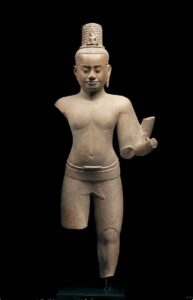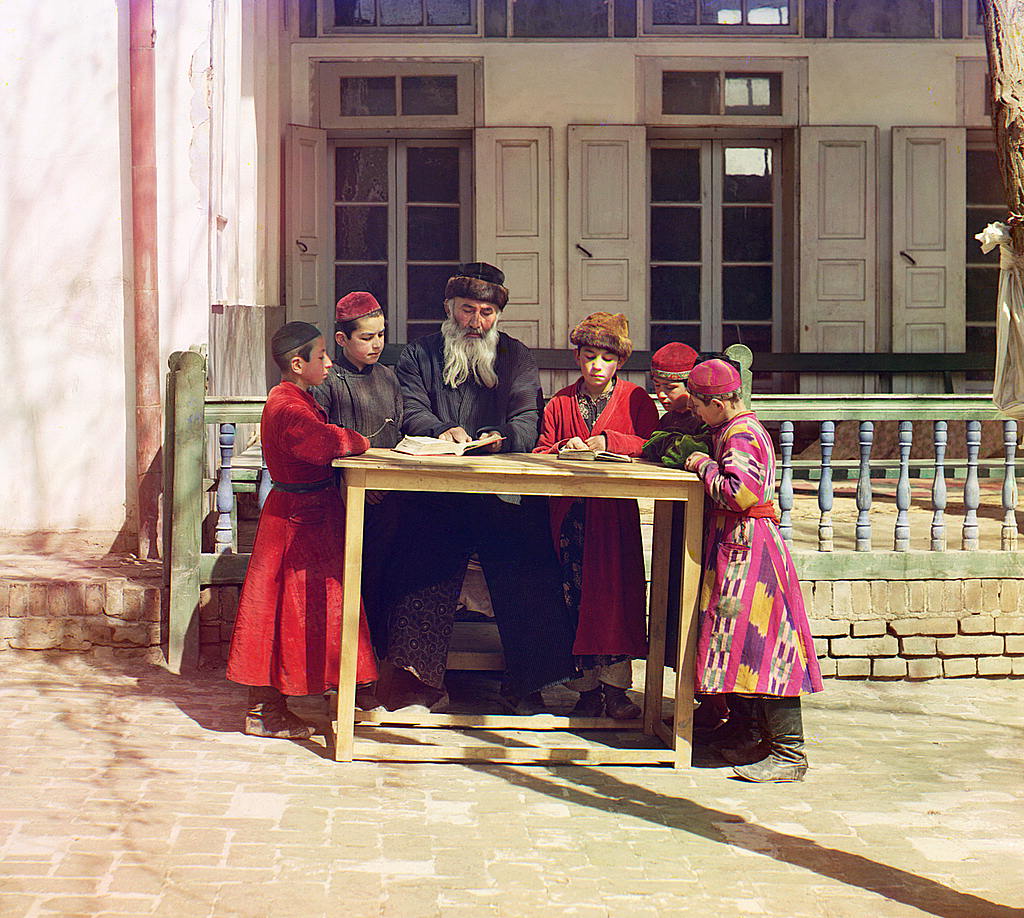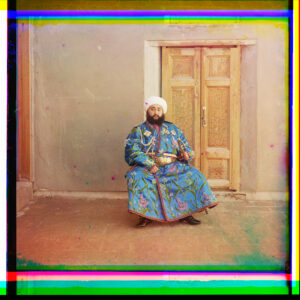
Standing Eight-Armed Avalokiteshvara, the Bodhisattva of Infinite Compassion, Angkor period, late 12th century, Cambodia or Thailand, courtesy Metropolitan Museum of Art, New York.
The Cultural Property Advisory Committee intends to meet January 30 – February 2, 2023 to review (1) extending and amending the cultural property agreement with the Government of Cambodia, in place since 1999 and (2) to review a new request from the Government of North Macedonia, and (3) to review a new request from the Government of Uzbekistan for cultural property import restrictions.
Requests to speak at the January 30, 2023, 4pm EST Virtual Open Session must be made by January 23. If you wish to register to speak you must submit your name and organizational affiliation in an email request to culprop@state.gov by January 23. After you pre-register you will receive an email response with a unique link and instructions on how to participate. Members of the public can speak for 5 minutes only. Written comments to the CPAC Committee can be of any length; they must be submitted before midnight EST on Jan 23, 2023.
Some additional information about these requests can be found here:
http://culturalpropertyobserver.blogspot.com/2022/11/cpac-to-meet-on-jan-30th-to-consider.html
On the current U.S. State Department policy of perpetually renewed and broadened cultural property agreements, please read:
2021 Cultural Agreements Deny Access to Art
and with respect to the 2023 Cambodian renewal, please read:
Cambodia and “Stone Temple Nationalism”
The direct link to submit written comments is
https://www.regulations.gov/document/DOS-2022-0048-0001
For the last two decades, the Cultural Heritage Center at the State Department’s Bureau of Educational and Cultural Affairs has administered the Cultural Property Advisory Committee. Under its supervision, the State Department has effectively redefined the purpose and role of the Cultural Property Implementation Act. Under U.S. law, the 1983 Cultural Property Implementation Act (CPIA), restrictions only apply to objects of “cultural significance.” The CPIA also limited import restrictions to objects that were subject to current looting in the requesting country. To be covered, objects had to have been actually discovered in the requesting country. If other market nations were trading in similar materials, restrictions have to be part of a “concerted international response” in which other nations had put similar restrictions in place. Restrictions on trade were to be made only if a less burdensome action was not feasible. A final mandatory element of the law stated that the US import restrictions had to “be consistent with the general interest of the international exchange of cultural property…”
Today, Designated Lists of restricted objects commonly include art and artifacts made from as long ago as 1,200,000 BC up to to the early 20th century. Trinkets, coins made in the millions, and repetitive objects are blocked along with objects of great artistic and historical importance. The three requests to be heard in January raise serious questions whether the requests are truly based upon U.S. law or influenced by a desire to halt the trade in virtually all objects from the three countries, including commercially-made textiles and other crafts made specifically for trade, regardless of the potential damage to U.S. public, museum, collector, and business interests.
Uzbekistan’s Request, as set forth on the website of the Cultural Heritage Bureau at the State Department:
Emir Alim Khan of Bukhara (1880-1944), photo Sergei Prokudin-Gorskii, 1911, color slide technique. Library of Congress.
“The Government of Uzbekistan seeks import restrictions on archaeological material dating from the Paleolithic period (50,000 BCE) to the 18th century CE and including the following periods, styles, and cultures: Paleolithic, Mesolithic, Neolithic, Ancient Bactrian, Korezm/Khorezm, Seleucid, Kangjiuy, Kushan, Greco-Bactrian, Ephthalite/Hephthalite, Turkic, Somanite/Samanid, Karakhanid, Korezmsakh/Khorezmsakh, Mongol, Timurid, Bukhara, Kiva/Khiva, and Uzbek periods. This material includes stone; ceramics, faience, and fired clay; metal; plaster, stucco, and unfired clay; painting; ivory and bone; glass; leather, birch bark, vellum, parchment, and paper; textiles; wood, shell, and other organic material; and human remains.”
“Requested ethnological material date from the 7th century CE to 1917 CE and come from the Early Islamic, Middle Islamic, and Uzbek periods. This material includes weapons of historical, artistic, scientific and other cultural value; artworks containing precious metals and precious stones; objects and their fragments; completely handmade paintings and drawings on any basis and from any materials; sculptural works made of any materials, including relief paintings; original artistic compositions and montages made of any materials; artistically decorated objects for the purpose of worship; engravings, prints, lithographs, xylographs, other types of graphics and their original printed forms; practical and decorative works of art (art objects made of glass, clay, wood, metal, bone, fabric and other materials); traditional folk arts and crafts; components and fragments of architecture, history, artistic monuments and monumental art monuments; books, as well as printed works of historical, scientific, artistic, and literary significance; unique manuscripts and documentary monuments, archival documents; musical instruments; coins, bonistics, orders, medals, seals, postcards (envelopes), postage stamps, numismatics, phaleristics, and other collectibles; objects important for branches of science such as mineralogy, paleontology, anatomy; household and scientific equipment and tools; and other movable objects, including copies of historical, scientific-artistic or other cultural significance, as well as copies protected by the state as historical and cultural monuments.”
[Ed. Please note that despite the obscure names and inaccuracies of the descriptions above, the intent is clearly to be all-encompassing from 50,000 BC onward. The list of objects is similarly uninformative, especially since it is not clear whether “practical and decorative works of art (art objects made of glass, clay, wood, metal, bone, fabric and other materials); traditional folk arts and crafts,” includes the most common of all “fabrics” and “traditional crafts”, i.e. carpets, costumes and textiles made both for home use and commercially throughout the 19th and early 20th century.]
North Macedonia’s Request:
Roof fresco of Pantokrator, Nativity of the Theotokos Church, Bitola, North Macedonia, photo by Petar Milošević, 15 April 2017, CCA-SA 4.0 International license.
“The Government of North Macedonia seeks import restrictions on archaeological and ethnological materials ranging from 300,000 BC to the 20th century AD, including from the prehistoric periods (Paleolithic, Neolithic, Chalcolithic, Bronze Age, Iron Age), classical antiquity (Classical, Hellenistic, Roman, and Late Roman periods), Medieval (Byzantine and Post-Byzantine periods), the Ottoman Period including the 19th century North Macedonian Revival, and the Modern Era. Requested archaeological material includes ceramics; stone; metal objects including coins; bone and ivory; and glass and faience; dating from the Paleolithic to the Ottoman Period.”
“Requested ethnological material includes three overarching categories: (1) Ethnological religious objects (Christian and Islamic) in stone, metal, ceramic, bone, ivory, wood, glass, textile, parchment, paper, and paintings from the 2nd century to the 20th century AD; (2) Artistic objects including vessels, monuments, and sculpture in ceramic, stone, metal, and wood; paintings; and mosaics from the 3rd century to the 20th century AD; and (3) ethnographic objects such as vessels, sculpture, monuments, tools, ornaments, musical instruments, clothing and other textiles, bags, and pipes from the 18th century to the 1950s AD.”
Cambodia’s Request:
Angkor, Cambodia, Preah Khan Temple, 27 November 2017, Photo Jakub Hałun, CCA-SA 4.0 International license.
“The Government of Cambodia seeks an extension of current import restrictions on archaeological material and an amendment of the cultural property agreement to include new categories of archaeological and ethnological materials. Newly requested archaeological material includes stone (e.g., sculpture, architectural materials, stelae, brick sculpture, jewelry, and stone tools); metal (e.g., statues, ritual and domestic objects, architectural materials, musical instruments, weapons and tools, and coins); ceramics (e.g., sculptures and vessels); glass beads; bone objects; and wood (e.g., architectural materials and sculpture) dating from the Pre-historical periods (circa 2500 BC) through AD 1750 from the entirety of Cambodia. This amendment also includes the archaeological objects of ethnic and religious minority cultures found throughout Cambodia.”
“Ethnological material requested dates from AD 1400 through 1891, and includes architectural elements from religious buildings (e.g., wooden doors and carved panels); sculpture (e.g., wooden figures and often decorated with lacquer, gold leaf, paint, and/or incrustations of glass); manuscripts (e.g., handwritten works on paper and/or palm leaf); funerary objects (e.g., ceramic or stone urns or wooden urns); and religious objects (e.g., bells, chariot fixtures, popil, musical instruments, and betel containers often made from bronze).”
UNESCO and the EU Gang Up on the Art Trade

Stamp of Afghanistan, 1958 depicting Paris UNESCO Headquarters.
Recent articles here at Cultural Property News have described major initiatives at UNESCO in 2022, from UNESCO’s attempt to write an “ethical code” for art dealers to proposed Model Rules that instead of “modifying” the 1970 UNESCO Convention, as UNESCO claims, would fundamentally alter it, and not in a good way.
The proposed “ethical code” suffered from UNESCO’s failure to confer first with art dealers to learn the rules and requirements of the major art dealer associations, the basics of the business, and the laws, regulations and tax systems that dealers operate under already.
The Model Rules are covered in CPN’s must-read feature article, UNESCO Model Provisions Could End Most Global Trade, November 2, 2022. They call for extra-territorial enforcement of foreign nationalizing laws and return of objects to countries where they were created thousands of years before, without requiring evidence that they were illicitly acquired.
As we reported, they would:
“apply severe restrictions to trade in an exceptionally broad range of objects, from national treasures to objects duplicated in the millions. They cover ethnological art and items mass produced for commerce as well as antiquities.”
“The Model Provisions clearly endorse state ownership of all cultural objects, including private and religious property – they would, for example, grant recognition of Middle Eastern and North African nations’ seizures of Jewish patrimony, Turkey and Azerbaijan’s control over Greek Orthodox and Armenian Christian heritage, and China’s claims for absolute control of all minority Tibetan and Uyghur heritage. The human and religious rights of religious and ethnic minorities in particular would be impacted by policies excessively restricting ownership of cultural heritage to governments that in many cases abuse minority communities or have forced them to leave the country without their possessions.”
Many different ‘initiatives’ are also currently being undertaken by the EU with the intention of regulating the art market. While these studies and action plans doubtless provide employment to a host of contractors and UNESCO interns – they have been undertaken without having even attempted to found out the facts about the industry they seek to regulate.
The International Association of Dealers in Ancient Art (IADAA) has compiled a partial list of EU initiatives currently ongoing and recently passed legislation:
- Regulation (EU) 2019/880 on the Import of Cultural Goods 2019 (DG TAXUD)
- EU Anti Money Laundering legislation – specifically targeting galleries (DG FIN)
- Restrictions on bio-diversity – impacting antiques (DG ENV)
- Action Plan to fight the illicit trade of cultural goods (DGs EAC, TAXUD, HOME, JUST)
- EC tender for research on the fight against trafficking of cultural goods (HORIZON)
- FATF study: Money Laundering and Terrorist Financing Associated with Arts, Antiquities and other Cultural Objects (2022) (Third Draft)
- UNESCO International Code of Ethics for Dealers
- Feasibility Study for a European asset registry in the context of the fight against money laundering (AML) and tax evasion
The IADAA comments:
“As IADAA has long argued, whatever else they do, lawmakers should focus on gathering more reliable data, communicating better with key official bodies including the Financial Intelligence Units, and encourage better data reporting at a national level by customs and other law enforcement bodies. Most of all, they need to engage with the art market properly at the earliest opportunity, taking notice of all the intelligence it has gathered.”
 Jewish schoolboys with their teacher in Samarkand, photo Sergei Prokudin-Gorskii, 1911, Library of Congress.
Jewish schoolboys with their teacher in Samarkand, photo Sergei Prokudin-Gorskii, 1911, Library of Congress. 




